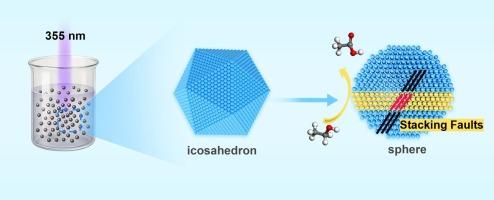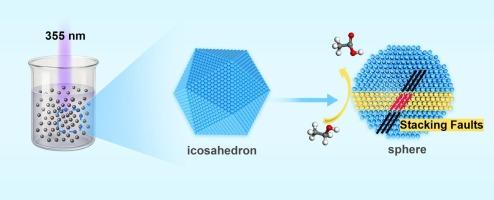激光诱导钯纳米粒子原子结构演化及其对乙醇电氧化的影响
IF 6.9
2区 材料科学
Q2 CHEMISTRY, PHYSICAL
引用次数: 0
摘要
钯纳米粒子的原子结构是决定其催化性能的关键。在本研究中,利用纳秒脉冲激光辐照方法完成了Pd NPs的原子结构演化(五重双层错缺陷-单晶)。采用有限元分析和分子动力学模拟相结合的方法对其机理进行了理论研究。激光照射在钯纳米粒子上产生局域温度场,驱动原子运动。钯纳米粒子经历快速加热和冷却,原子结构的演化受动态应力振荡的驱动。激光辐照Pd NPs对乙醇电氧化(EOR)具有较好的催化活性和抗co中毒能力。此外,利用密度泛函理论(DFT)分析了钯纳米粒子的催化机理,阐明了层错结构和微应变对钯纳米粒子催化性能的影响。本研究为激光制备缺陷纳米催化剂提供了理论依据。本文章由计算机程序翻译,如有差异,请以英文原文为准。


Laser-induced atomic structure evolution of palladium nanoparticles and its effect on ethanol electro-oxidation
The atomic structure of palladium nanoparticles (Pd NPs) is crucial for determining their catalytic performance. In this study, the atomic structure evolution (five-fold twin—stacking fault defect—single crystal) of Pd NPs is accomplished using a nanosecond pulsed laser irradiation method. The mechanism is theoretically investigated by combining finite element analysis (FEA) with molecular dynamics (MD) simulations. The laser irradiation induces a localized temperature field on the Pd NPs and drives the motion of atoms. The Pd NPs undergo fast heating and cooling, and the evolution of the atomic structure is driven by dynamic stress oscillations. The laser-irradiated Pd NPs exhibit improved catalytic activity and anti-CO poisoning ability toward ethanol electro-oxidation (EOR). Furthermore, the catalytic mechanism is investigated using the density functional theory (DFT) calculations, which clarify the effects of the stacking fault structure and the micro-strain in improving the catalytic performance of Pd NPs. This study provides a theoretical basis for the laser fabrication of defective nano-catalysts.
求助全文
通过发布文献求助,成功后即可免费获取论文全文。
去求助
来源期刊

Applied Surface Science
工程技术-材料科学:膜
CiteScore
12.50
自引率
7.50%
发文量
3393
审稿时长
67 days
期刊介绍:
Applied Surface Science covers topics contributing to a better understanding of surfaces, interfaces, nanostructures and their applications. The journal is concerned with scientific research on the atomic and molecular level of material properties determined with specific surface analytical techniques and/or computational methods, as well as the processing of such structures.
 求助内容:
求助内容: 应助结果提醒方式:
应助结果提醒方式:


